International HR Director Competencies: A Critical Analysis
VerifiedAdded on 2022/10/13
|5
|1594
|14
Essay
AI Summary
This essay critically discusses the essential competencies required for an international HR Director to operate effectively across diverse cultures in the contemporary and future business landscape. It emphasizes the importance of cultural intelligence, emotional intelligence, and a global mindset. The essay argues that a successful HR leader must be adept at managing conflicts arising from cultural differences, fostering a positive attitude, and demonstrating the value of diversity and inclusion. It also highlights the significance of adapting leadership practices to different countries and understanding the moral values and cultural needs of employees. The essay references various academic sources to support the arguments and concludes that managing diversity is crucial for organizational success in the era of globalization, requiring HR leaders to possess a range of skills and capabilities to navigate cultural complexities and build strong relationships among diverse teams.
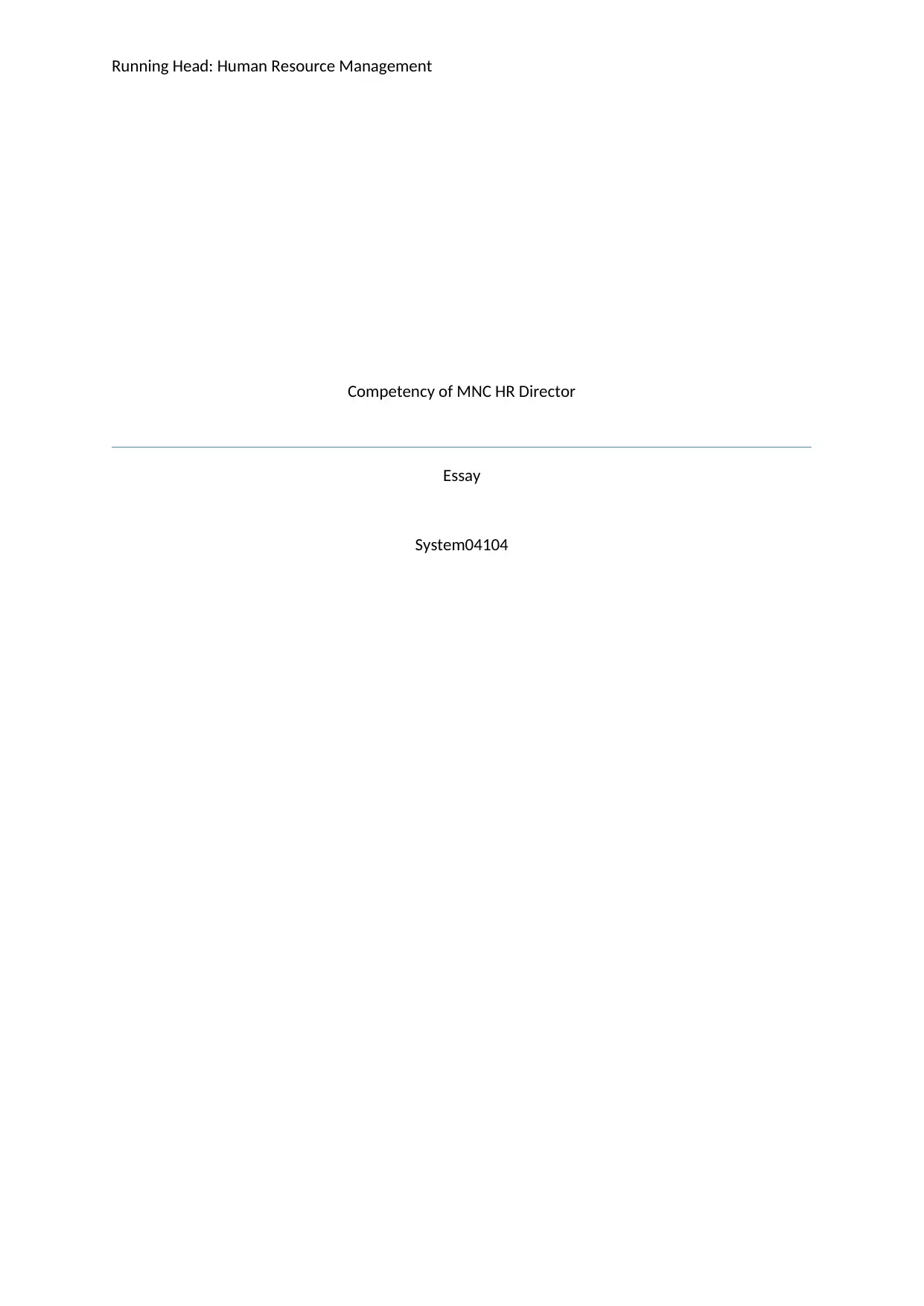
Running Head: Human Resource Management
Competency of MNC HR Director
Essay
System04104
Competency of MNC HR Director
Essay
System04104
Paraphrase This Document
Need a fresh take? Get an instant paraphrase of this document with our AI Paraphraser
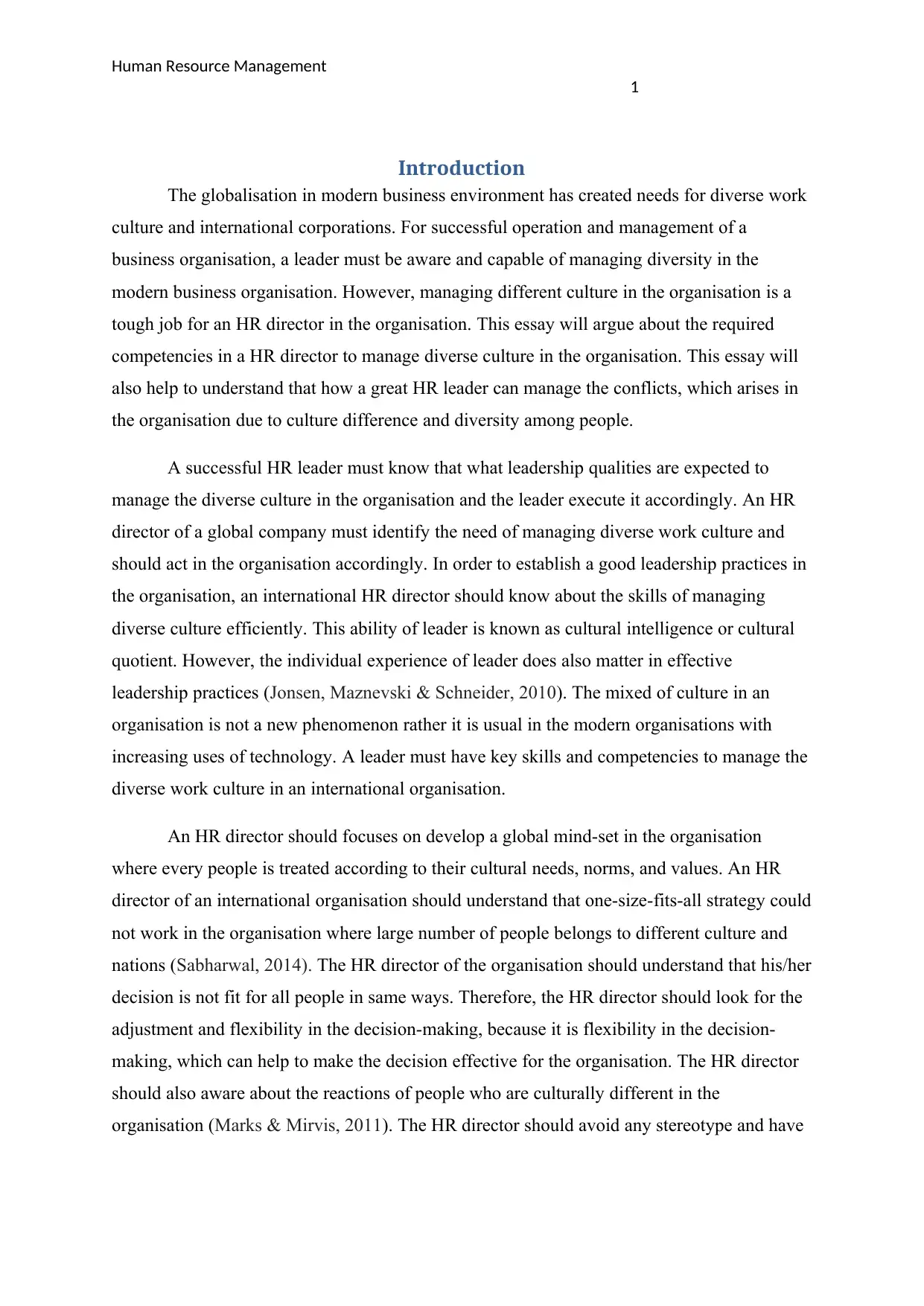
Human Resource Management
1
Introduction
The globalisation in modern business environment has created needs for diverse work
culture and international corporations. For successful operation and management of a
business organisation, a leader must be aware and capable of managing diversity in the
modern business organisation. However, managing different culture in the organisation is a
tough job for an HR director in the organisation. This essay will argue about the required
competencies in a HR director to manage diverse culture in the organisation. This essay will
also help to understand that how a great HR leader can manage the conflicts, which arises in
the organisation due to culture difference and diversity among people.
A successful HR leader must know that what leadership qualities are expected to
manage the diverse culture in the organisation and the leader execute it accordingly. An HR
director of a global company must identify the need of managing diverse work culture and
should act in the organisation accordingly. In order to establish a good leadership practices in
the organisation, an international HR director should know about the skills of managing
diverse culture efficiently. This ability of leader is known as cultural intelligence or cultural
quotient. However, the individual experience of leader does also matter in effective
leadership practices (Jonsen, Maznevski & Schneider, 2010). The mixed of culture in an
organisation is not a new phenomenon rather it is usual in the modern organisations with
increasing uses of technology. A leader must have key skills and competencies to manage the
diverse work culture in an international organisation.
An HR director should focuses on develop a global mind-set in the organisation
where every people is treated according to their cultural needs, norms, and values. An HR
director of an international organisation should understand that one-size-fits-all strategy could
not work in the organisation where large number of people belongs to different culture and
nations (Sabharwal, 2014). The HR director of the organisation should understand that his/her
decision is not fit for all people in same ways. Therefore, the HR director should look for the
adjustment and flexibility in the decision-making, because it is flexibility in the decision-
making, which can help to make the decision effective for the organisation. The HR director
should also aware about the reactions of people who are culturally different in the
organisation (Marks & Mirvis, 2011). The HR director should avoid any stereotype and have
1
Introduction
The globalisation in modern business environment has created needs for diverse work
culture and international corporations. For successful operation and management of a
business organisation, a leader must be aware and capable of managing diversity in the
modern business organisation. However, managing different culture in the organisation is a
tough job for an HR director in the organisation. This essay will argue about the required
competencies in a HR director to manage diverse culture in the organisation. This essay will
also help to understand that how a great HR leader can manage the conflicts, which arises in
the organisation due to culture difference and diversity among people.
A successful HR leader must know that what leadership qualities are expected to
manage the diverse culture in the organisation and the leader execute it accordingly. An HR
director of a global company must identify the need of managing diverse work culture and
should act in the organisation accordingly. In order to establish a good leadership practices in
the organisation, an international HR director should know about the skills of managing
diverse culture efficiently. This ability of leader is known as cultural intelligence or cultural
quotient. However, the individual experience of leader does also matter in effective
leadership practices (Jonsen, Maznevski & Schneider, 2010). The mixed of culture in an
organisation is not a new phenomenon rather it is usual in the modern organisations with
increasing uses of technology. A leader must have key skills and competencies to manage the
diverse work culture in an international organisation.
An HR director should focuses on develop a global mind-set in the organisation
where every people is treated according to their cultural needs, norms, and values. An HR
director of an international organisation should understand that one-size-fits-all strategy could
not work in the organisation where large number of people belongs to different culture and
nations (Sabharwal, 2014). The HR director of the organisation should understand that his/her
decision is not fit for all people in same ways. Therefore, the HR director should look for the
adjustment and flexibility in the decision-making, because it is flexibility in the decision-
making, which can help to make the decision effective for the organisation. The HR director
should also aware about the reactions of people who are culturally different in the
organisation (Marks & Mirvis, 2011). The HR director should avoid any stereotype and have
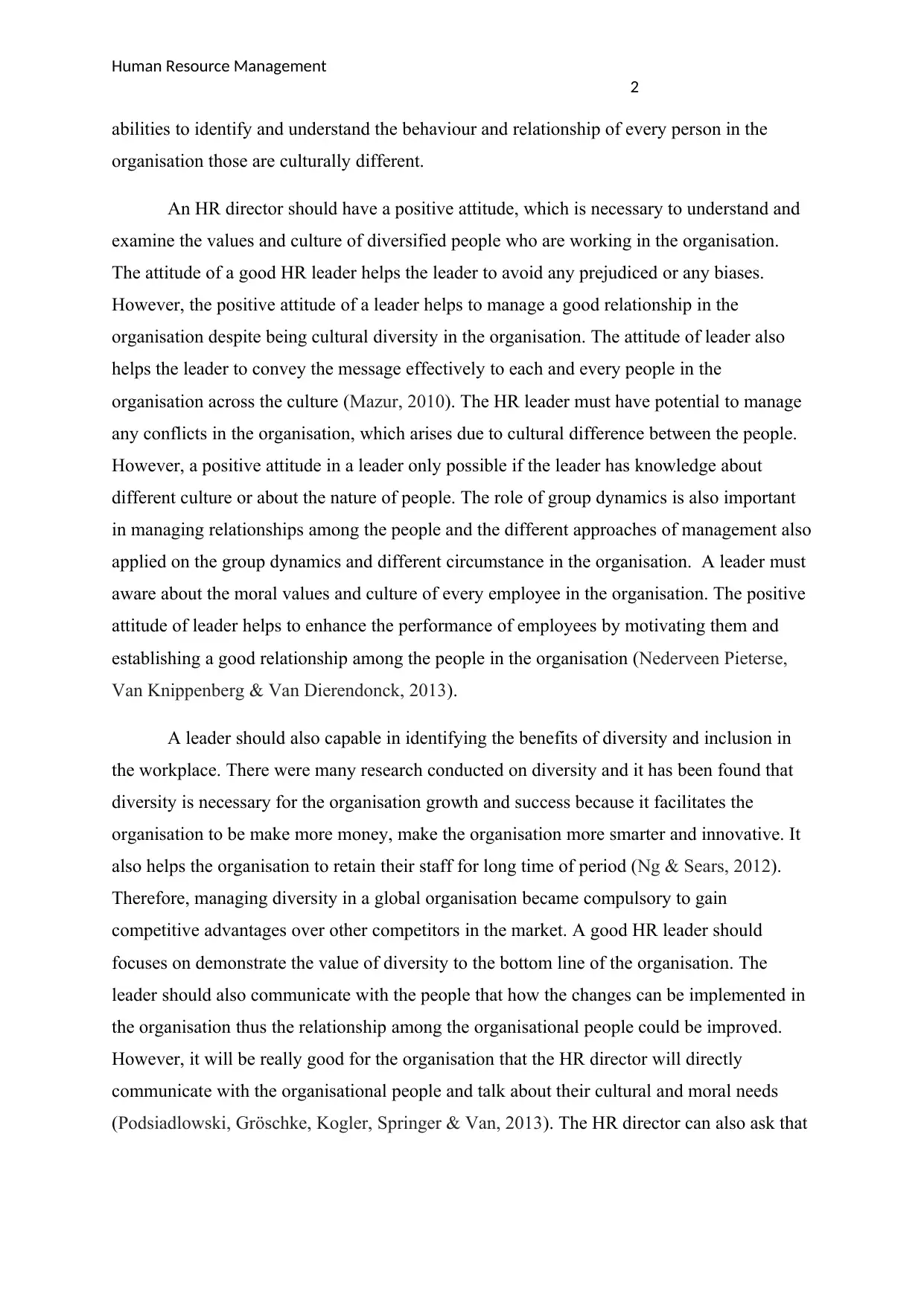
Human Resource Management
2
abilities to identify and understand the behaviour and relationship of every person in the
organisation those are culturally different.
An HR director should have a positive attitude, which is necessary to understand and
examine the values and culture of diversified people who are working in the organisation.
The attitude of a good HR leader helps the leader to avoid any prejudiced or any biases.
However, the positive attitude of a leader helps to manage a good relationship in the
organisation despite being cultural diversity in the organisation. The attitude of leader also
helps the leader to convey the message effectively to each and every people in the
organisation across the culture (Mazur, 2010). The HR leader must have potential to manage
any conflicts in the organisation, which arises due to cultural difference between the people.
However, a positive attitude in a leader only possible if the leader has knowledge about
different culture or about the nature of people. The role of group dynamics is also important
in managing relationships among the people and the different approaches of management also
applied on the group dynamics and different circumstance in the organisation. A leader must
aware about the moral values and culture of every employee in the organisation. The positive
attitude of leader helps to enhance the performance of employees by motivating them and
establishing a good relationship among the people in the organisation (Nederveen Pieterse,
Van Knippenberg & Van Dierendonck, 2013).
A leader should also capable in identifying the benefits of diversity and inclusion in
the workplace. There were many research conducted on diversity and it has been found that
diversity is necessary for the organisation growth and success because it facilitates the
organisation to be make more money, make the organisation more smarter and innovative. It
also helps the organisation to retain their staff for long time of period (Ng & Sears, 2012).
Therefore, managing diversity in a global organisation became compulsory to gain
competitive advantages over other competitors in the market. A good HR leader should
focuses on demonstrate the value of diversity to the bottom line of the organisation. The
leader should also communicate with the people that how the changes can be implemented in
the organisation thus the relationship among the organisational people could be improved.
However, it will be really good for the organisation that the HR director will directly
communicate with the organisational people and talk about their cultural and moral needs
(Podsiadlowski, Gröschke, Kogler, Springer & Van, 2013). The HR director can also ask that
2
abilities to identify and understand the behaviour and relationship of every person in the
organisation those are culturally different.
An HR director should have a positive attitude, which is necessary to understand and
examine the values and culture of diversified people who are working in the organisation.
The attitude of a good HR leader helps the leader to avoid any prejudiced or any biases.
However, the positive attitude of a leader helps to manage a good relationship in the
organisation despite being cultural diversity in the organisation. The attitude of leader also
helps the leader to convey the message effectively to each and every people in the
organisation across the culture (Mazur, 2010). The HR leader must have potential to manage
any conflicts in the organisation, which arises due to cultural difference between the people.
However, a positive attitude in a leader only possible if the leader has knowledge about
different culture or about the nature of people. The role of group dynamics is also important
in managing relationships among the people and the different approaches of management also
applied on the group dynamics and different circumstance in the organisation. A leader must
aware about the moral values and culture of every employee in the organisation. The positive
attitude of leader helps to enhance the performance of employees by motivating them and
establishing a good relationship among the people in the organisation (Nederveen Pieterse,
Van Knippenberg & Van Dierendonck, 2013).
A leader should also capable in identifying the benefits of diversity and inclusion in
the workplace. There were many research conducted on diversity and it has been found that
diversity is necessary for the organisation growth and success because it facilitates the
organisation to be make more money, make the organisation more smarter and innovative. It
also helps the organisation to retain their staff for long time of period (Ng & Sears, 2012).
Therefore, managing diversity in a global organisation became compulsory to gain
competitive advantages over other competitors in the market. A good HR leader should
focuses on demonstrate the value of diversity to the bottom line of the organisation. The
leader should also communicate with the people that how the changes can be implemented in
the organisation thus the relationship among the organisational people could be improved.
However, it will be really good for the organisation that the HR director will directly
communicate with the organisational people and talk about their cultural and moral needs
(Podsiadlowski, Gröschke, Kogler, Springer & Van, 2013). The HR director can also ask that
⊘ This is a preview!⊘
Do you want full access?
Subscribe today to unlock all pages.

Trusted by 1+ million students worldwide
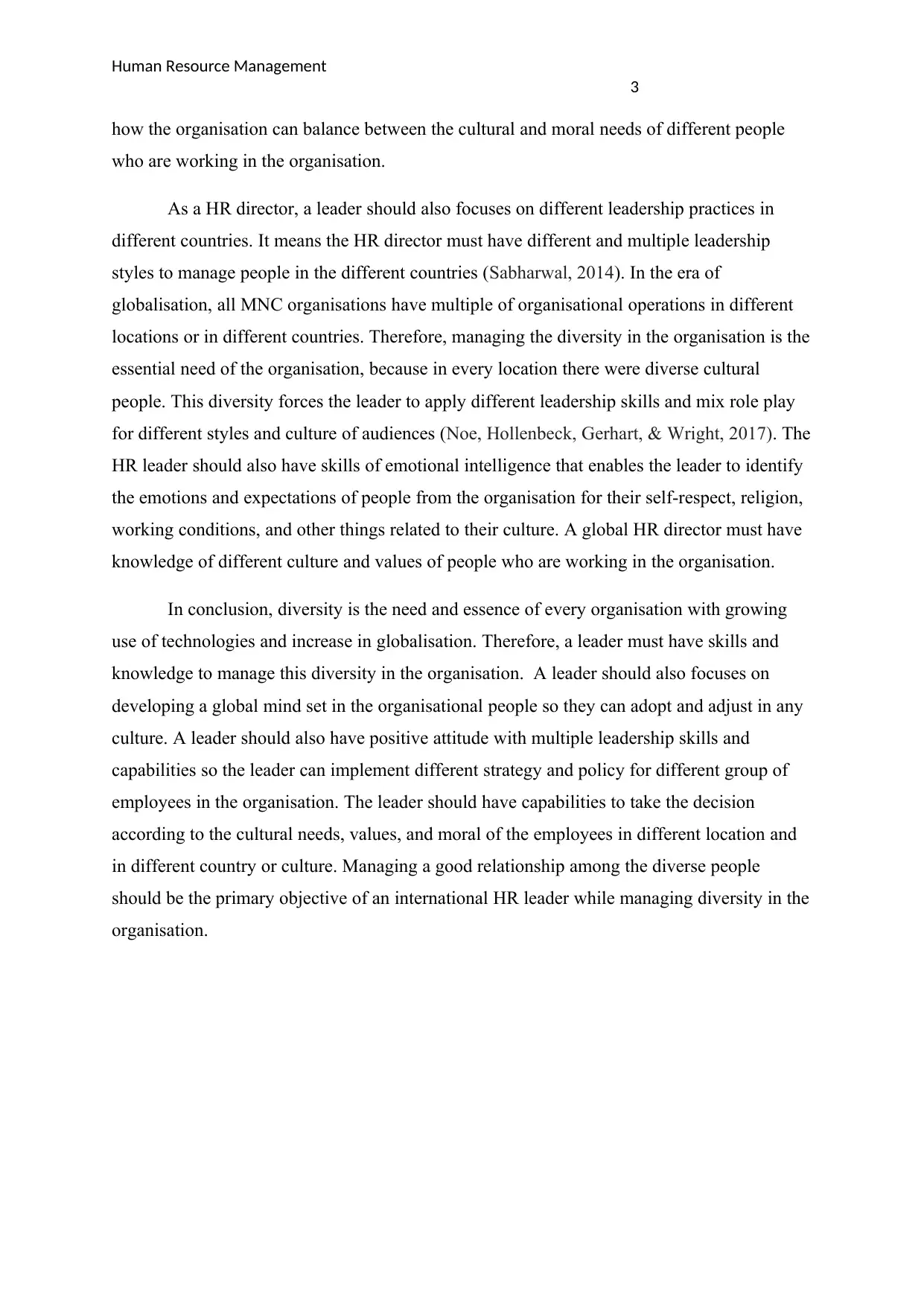
Human Resource Management
3
how the organisation can balance between the cultural and moral needs of different people
who are working in the organisation.
As a HR director, a leader should also focuses on different leadership practices in
different countries. It means the HR director must have different and multiple leadership
styles to manage people in the different countries (Sabharwal, 2014). In the era of
globalisation, all MNC organisations have multiple of organisational operations in different
locations or in different countries. Therefore, managing the diversity in the organisation is the
essential need of the organisation, because in every location there were diverse cultural
people. This diversity forces the leader to apply different leadership skills and mix role play
for different styles and culture of audiences (Noe, Hollenbeck, Gerhart, & Wright, 2017). The
HR leader should also have skills of emotional intelligence that enables the leader to identify
the emotions and expectations of people from the organisation for their self-respect, religion,
working conditions, and other things related to their culture. A global HR director must have
knowledge of different culture and values of people who are working in the organisation.
In conclusion, diversity is the need and essence of every organisation with growing
use of technologies and increase in globalisation. Therefore, a leader must have skills and
knowledge to manage this diversity in the organisation. A leader should also focuses on
developing a global mind set in the organisational people so they can adopt and adjust in any
culture. A leader should also have positive attitude with multiple leadership skills and
capabilities so the leader can implement different strategy and policy for different group of
employees in the organisation. The leader should have capabilities to take the decision
according to the cultural needs, values, and moral of the employees in different location and
in different country or culture. Managing a good relationship among the diverse people
should be the primary objective of an international HR leader while managing diversity in the
organisation.
3
how the organisation can balance between the cultural and moral needs of different people
who are working in the organisation.
As a HR director, a leader should also focuses on different leadership practices in
different countries. It means the HR director must have different and multiple leadership
styles to manage people in the different countries (Sabharwal, 2014). In the era of
globalisation, all MNC organisations have multiple of organisational operations in different
locations or in different countries. Therefore, managing the diversity in the organisation is the
essential need of the organisation, because in every location there were diverse cultural
people. This diversity forces the leader to apply different leadership skills and mix role play
for different styles and culture of audiences (Noe, Hollenbeck, Gerhart, & Wright, 2017). The
HR leader should also have skills of emotional intelligence that enables the leader to identify
the emotions and expectations of people from the organisation for their self-respect, religion,
working conditions, and other things related to their culture. A global HR director must have
knowledge of different culture and values of people who are working in the organisation.
In conclusion, diversity is the need and essence of every organisation with growing
use of technologies and increase in globalisation. Therefore, a leader must have skills and
knowledge to manage this diversity in the organisation. A leader should also focuses on
developing a global mind set in the organisational people so they can adopt and adjust in any
culture. A leader should also have positive attitude with multiple leadership skills and
capabilities so the leader can implement different strategy and policy for different group of
employees in the organisation. The leader should have capabilities to take the decision
according to the cultural needs, values, and moral of the employees in different location and
in different country or culture. Managing a good relationship among the diverse people
should be the primary objective of an international HR leader while managing diversity in the
organisation.
Paraphrase This Document
Need a fresh take? Get an instant paraphrase of this document with our AI Paraphraser
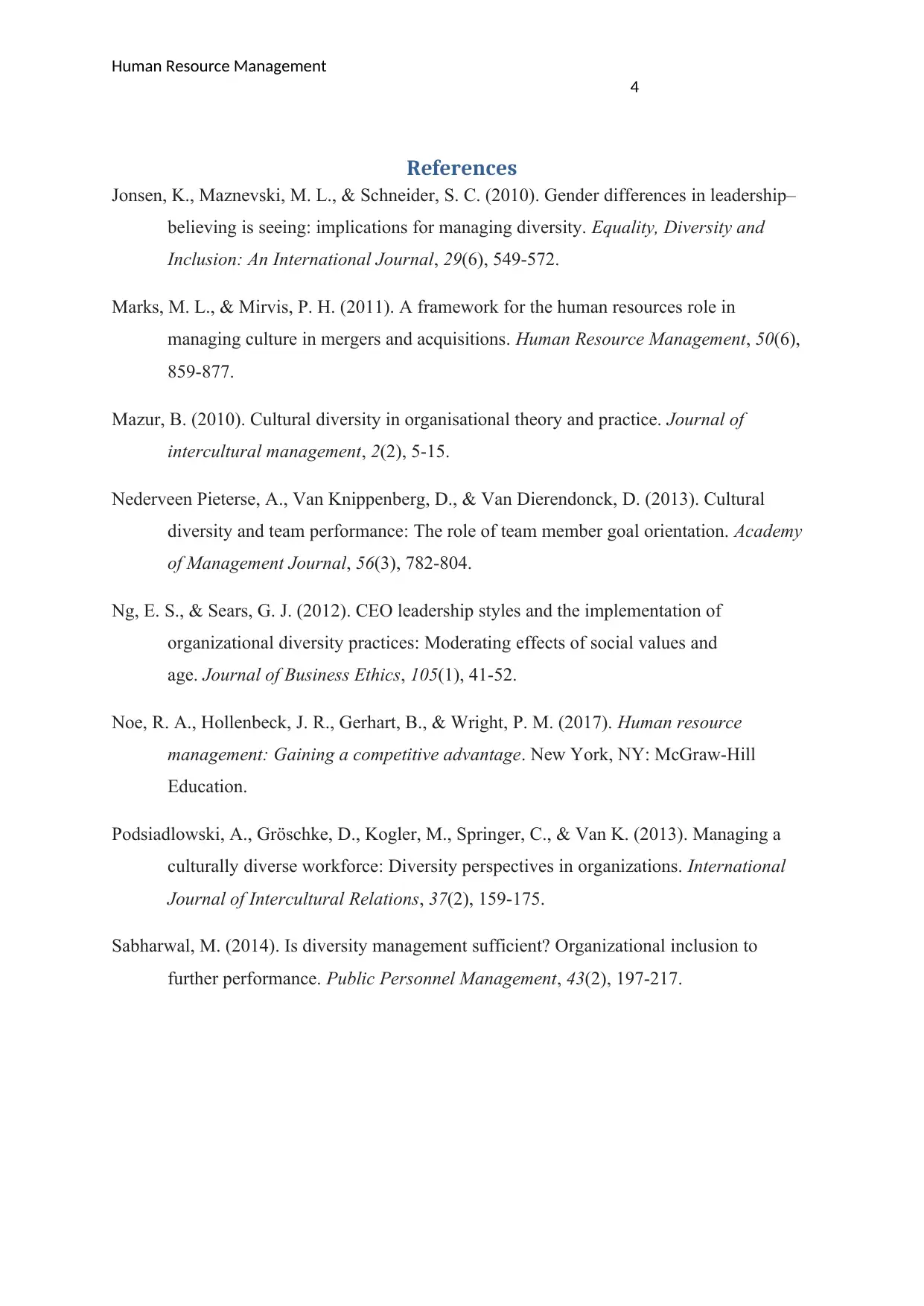
Human Resource Management
4
References
Jonsen, K., Maznevski, M. L., & Schneider, S. C. (2010). Gender differences in leadership–
believing is seeing: implications for managing diversity. Equality, Diversity and
Inclusion: An International Journal, 29(6), 549-572.
Marks, M. L., & Mirvis, P. H. (2011). A framework for the human resources role in
managing culture in mergers and acquisitions. Human Resource Management, 50(6),
859-877.
Mazur, B. (2010). Cultural diversity in organisational theory and practice. Journal of
intercultural management, 2(2), 5-15.
Nederveen Pieterse, A., Van Knippenberg, D., & Van Dierendonck, D. (2013). Cultural
diversity and team performance: The role of team member goal orientation. Academy
of Management Journal, 56(3), 782-804.
Ng, E. S., & Sears, G. J. (2012). CEO leadership styles and the implementation of
organizational diversity practices: Moderating effects of social values and
age. Journal of Business Ethics, 105(1), 41-52.
Noe, R. A., Hollenbeck, J. R., Gerhart, B., & Wright, P. M. (2017). Human resource
management: Gaining a competitive advantage. New York, NY: McGraw-Hill
Education.
Podsiadlowski, A., Gröschke, D., Kogler, M., Springer, C., & Van K. (2013). Managing a
culturally diverse workforce: Diversity perspectives in organizations. International
Journal of Intercultural Relations, 37(2), 159-175.
Sabharwal, M. (2014). Is diversity management sufficient? Organizational inclusion to
further performance. Public Personnel Management, 43(2), 197-217.
4
References
Jonsen, K., Maznevski, M. L., & Schneider, S. C. (2010). Gender differences in leadership–
believing is seeing: implications for managing diversity. Equality, Diversity and
Inclusion: An International Journal, 29(6), 549-572.
Marks, M. L., & Mirvis, P. H. (2011). A framework for the human resources role in
managing culture in mergers and acquisitions. Human Resource Management, 50(6),
859-877.
Mazur, B. (2010). Cultural diversity in organisational theory and practice. Journal of
intercultural management, 2(2), 5-15.
Nederveen Pieterse, A., Van Knippenberg, D., & Van Dierendonck, D. (2013). Cultural
diversity and team performance: The role of team member goal orientation. Academy
of Management Journal, 56(3), 782-804.
Ng, E. S., & Sears, G. J. (2012). CEO leadership styles and the implementation of
organizational diversity practices: Moderating effects of social values and
age. Journal of Business Ethics, 105(1), 41-52.
Noe, R. A., Hollenbeck, J. R., Gerhart, B., & Wright, P. M. (2017). Human resource
management: Gaining a competitive advantage. New York, NY: McGraw-Hill
Education.
Podsiadlowski, A., Gröschke, D., Kogler, M., Springer, C., & Van K. (2013). Managing a
culturally diverse workforce: Diversity perspectives in organizations. International
Journal of Intercultural Relations, 37(2), 159-175.
Sabharwal, M. (2014). Is diversity management sufficient? Organizational inclusion to
further performance. Public Personnel Management, 43(2), 197-217.
1 out of 5
Related Documents
Your All-in-One AI-Powered Toolkit for Academic Success.
+13062052269
info@desklib.com
Available 24*7 on WhatsApp / Email
![[object Object]](/_next/static/media/star-bottom.7253800d.svg)
Unlock your academic potential
Copyright © 2020–2025 A2Z Services. All Rights Reserved. Developed and managed by ZUCOL.





